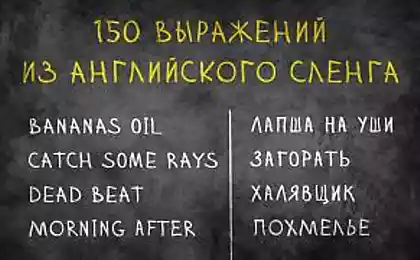1114
The annual "Tomato Festival"
At the last week of August in the town of Bunol (Bunol), in the east of Spain, begins the annual "Tomato Festival", dedicated to the departing summer. Like all Spanish festivals, it takes place with festive fireworks, music, dancing and free food. But the tomato festival, and there is one distinguishing feature, which attracts crowds of tourists in the Bunol, is the culmination of the festival - La Tomatina tomato fight (La Tomatina), passing the town square.
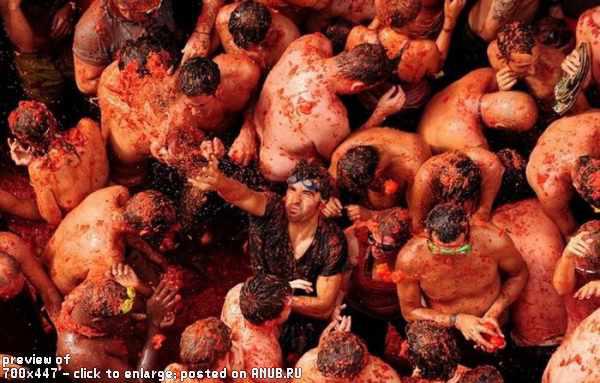
The signal for the beginning of the battle is a special firecracker that runs on Wednesday at 11 hours from the Town Hall. At this signal on the streets there are several trucks loaded with the protagonists of the feast, ripe tomatoes, which are missiles. The participants of the festival (which is the entire town of Buñol) ran under a hail of tomatoes to the machines, grab shells and fun revenge to those who first reached the truck.
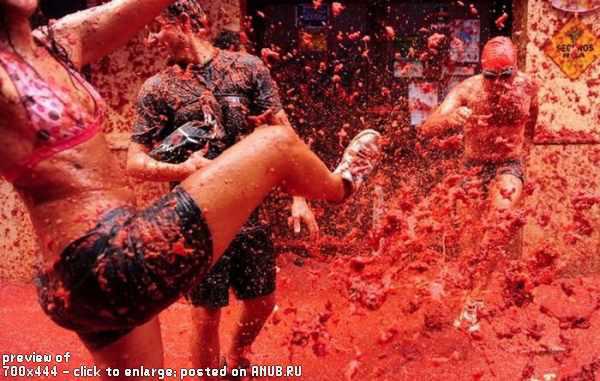
However, the target can be any being within reach, the main task of the participants, who, incidentally, are considered to be all fired tomatoes neighbor, let alone who they will - not so important. If we consider that taking part in this fun about forty thousand people, and the number of shells in the hundreds tons of tomatoes, it is easy to imagine what happens to the town square and city residents a few minutes after the start of tomato shootout.
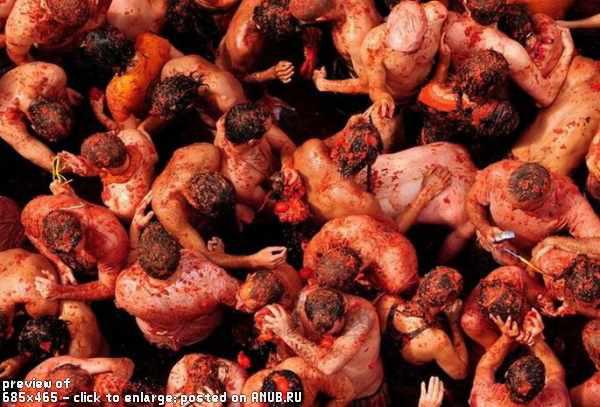
In the battle lasting two hours closed almost all the bars, cafes, restaurants and all public places, and windows and doors hang special plastic panels. Tomatina the participants prefer a reasonable minimalism in clothes stay clean since the day it is difficult to even outside of urban areas. The term "tomato river" is often used when describing the violence of tomato - not witty.
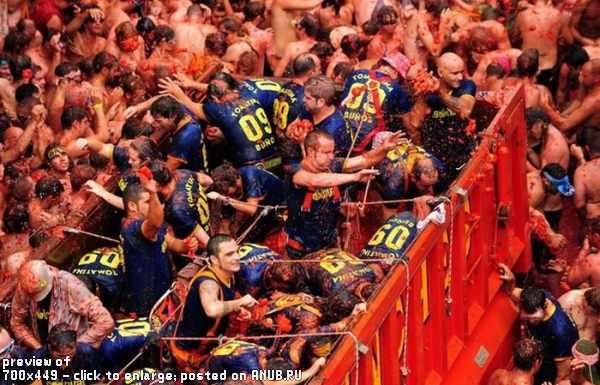
The historical roots of this unusual holiday leave at the time of Franco's dictatorship. According to one version, throwing each other tomato served as a symbolic protest of his regime. But most likely, a similar meaning was given tomato battles later, when the local festival has become famous across Spain.

The very first tomato massacre was recorded in 1945, when at the end of the summer festival in Buñol, a group of young people, through negligence or wanting to have fun, dropped a big figure of one of the participants in the parade, which was within the participant. Rising, he did not appreciate the joke and began to brawl, to which quickly joined his friends. The clash took place near the stalls with vegetables, tomatoes and immediately began throwing projectiles. Podospevshaya police dispersed fighters and forced them to pay for the spoiled vegetables, but exactly a year later they got there and already with their tomatoes.

Gradually the tomato began to skirmish wide and, despite the dissatisfaction of the police, they are attended by more and more people. In 1950 the local authorities had not prevented the implementation of Tomatina, I started to be called that day. But the temperamental Spaniards are not always limited to throwing tomatoes at each other, sometimes we fall under the distribution of vegetables and influential, which led to the banning of the holiday in 1957. Frustrated that the Spaniards made a crowded funeral Tomatina, in which a huge coffin with tomato carried through the streets of the city, and the funeral procession, according to the rules, accompanied by an orchestra and mourners. Under pressure from the citizens, in 1959 the local authorities were forced to lift the ban, and to recognize the Tomatina official holiday Bunyola.
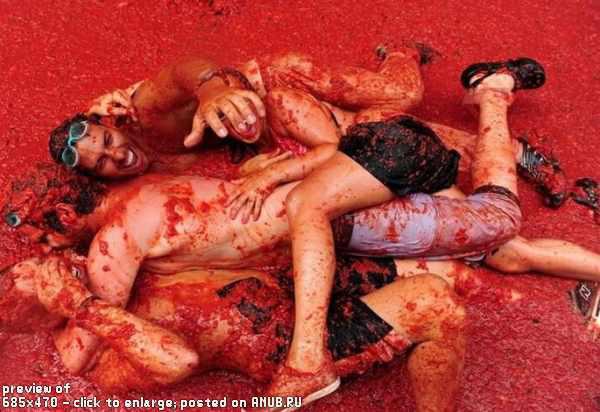
At the same time it adopted the rules of this feast acting to this day. Bans are only four:
- The beginning and end of the battle is strictly determined by the signal from the Town Hall firecrackers;
- You can not throw anything other than tomatoes, and themselves to be crushed tomatoes before throwing to avoid injury;
- It is forbidden to tear each other's clothes;
- Do not interfere with the movement of trucks with tomatoes.
Thanks to these simple rules, no celebration of La Tomatina has not led to serious incidents.

Until 1975, for their shells every resident to pay out of pocket, bringing tomatoes to celebrate with them. And in the 75th haul "ammunition" began the monks of the Order of St. Louis Bertrand, the patron saint of the city. Five years later, for the organization of the festival took municipality, dramatically increasing the number of participants of the festival and the amount of scattered tomatoes.
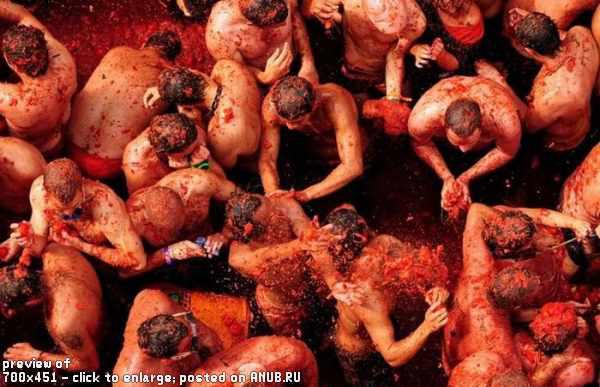
End tomato battles dip in the pool filled with tomato juice, ham and raffle traditional Iberian pig. By the end of the holiday tomato mush under the feet up the ankle and nearby houses as well, and participants disguise red. After the battles of the area is washed, and then a few more days lasts Tomato Festival, the last festival of the departing summer.



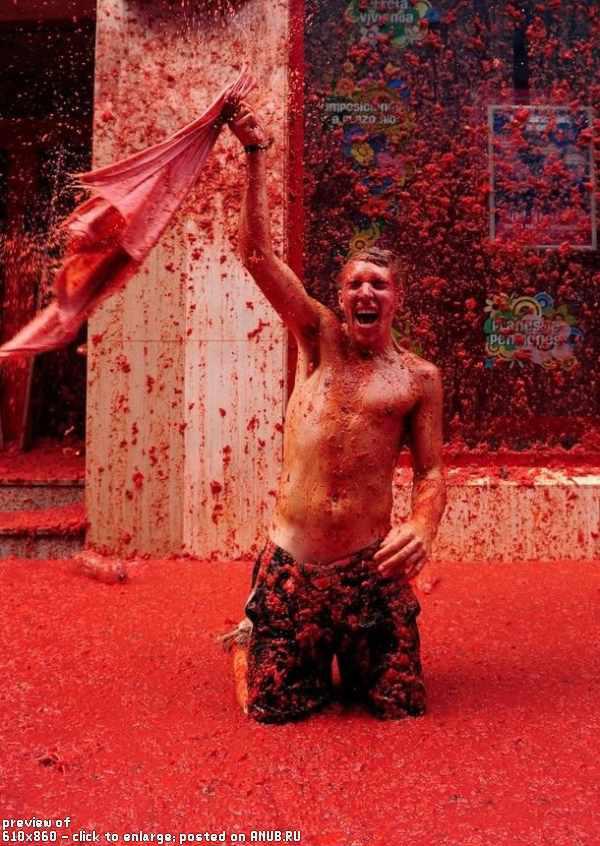
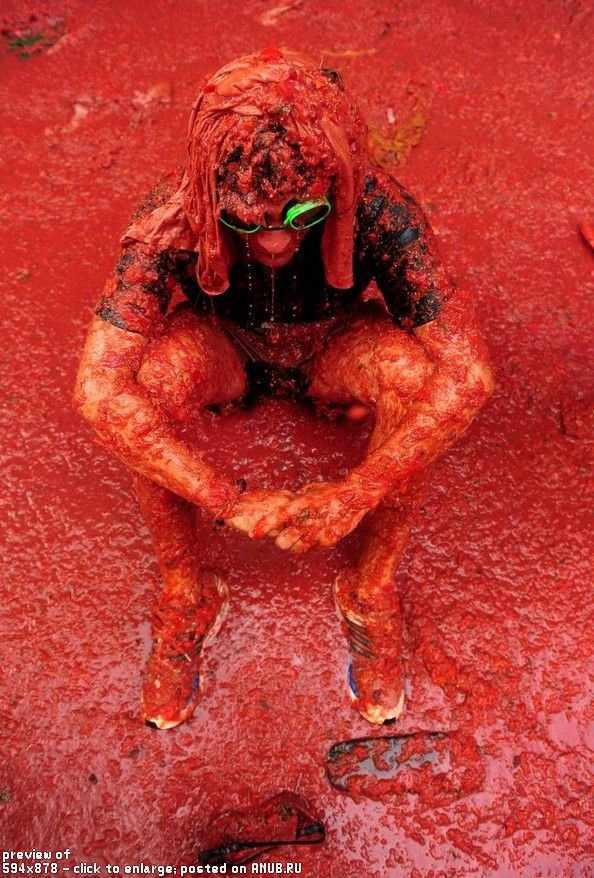

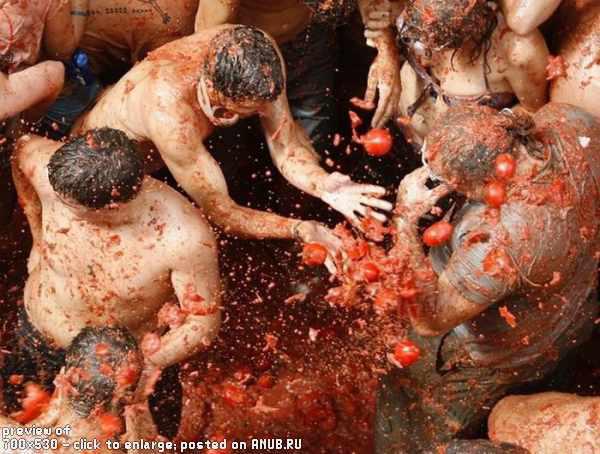
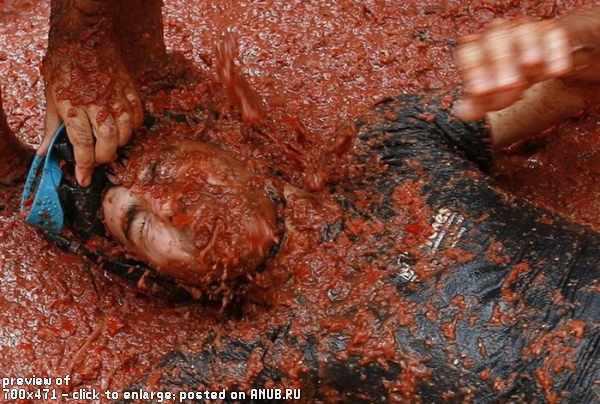


The signal for the beginning of the battle is a special firecracker that runs on Wednesday at 11 hours from the Town Hall. At this signal on the streets there are several trucks loaded with the protagonists of the feast, ripe tomatoes, which are missiles. The participants of the festival (which is the entire town of Buñol) ran under a hail of tomatoes to the machines, grab shells and fun revenge to those who first reached the truck.

However, the target can be any being within reach, the main task of the participants, who, incidentally, are considered to be all fired tomatoes neighbor, let alone who they will - not so important. If we consider that taking part in this fun about forty thousand people, and the number of shells in the hundreds tons of tomatoes, it is easy to imagine what happens to the town square and city residents a few minutes after the start of tomato shootout.

In the battle lasting two hours closed almost all the bars, cafes, restaurants and all public places, and windows and doors hang special plastic panels. Tomatina the participants prefer a reasonable minimalism in clothes stay clean since the day it is difficult to even outside of urban areas. The term "tomato river" is often used when describing the violence of tomato - not witty.

The historical roots of this unusual holiday leave at the time of Franco's dictatorship. According to one version, throwing each other tomato served as a symbolic protest of his regime. But most likely, a similar meaning was given tomato battles later, when the local festival has become famous across Spain.

The very first tomato massacre was recorded in 1945, when at the end of the summer festival in Buñol, a group of young people, through negligence or wanting to have fun, dropped a big figure of one of the participants in the parade, which was within the participant. Rising, he did not appreciate the joke and began to brawl, to which quickly joined his friends. The clash took place near the stalls with vegetables, tomatoes and immediately began throwing projectiles. Podospevshaya police dispersed fighters and forced them to pay for the spoiled vegetables, but exactly a year later they got there and already with their tomatoes.

Gradually the tomato began to skirmish wide and, despite the dissatisfaction of the police, they are attended by more and more people. In 1950 the local authorities had not prevented the implementation of Tomatina, I started to be called that day. But the temperamental Spaniards are not always limited to throwing tomatoes at each other, sometimes we fall under the distribution of vegetables and influential, which led to the banning of the holiday in 1957. Frustrated that the Spaniards made a crowded funeral Tomatina, in which a huge coffin with tomato carried through the streets of the city, and the funeral procession, according to the rules, accompanied by an orchestra and mourners. Under pressure from the citizens, in 1959 the local authorities were forced to lift the ban, and to recognize the Tomatina official holiday Bunyola.

At the same time it adopted the rules of this feast acting to this day. Bans are only four:
- The beginning and end of the battle is strictly determined by the signal from the Town Hall firecrackers;
- You can not throw anything other than tomatoes, and themselves to be crushed tomatoes before throwing to avoid injury;
- It is forbidden to tear each other's clothes;
- Do not interfere with the movement of trucks with tomatoes.
Thanks to these simple rules, no celebration of La Tomatina has not led to serious incidents.

Until 1975, for their shells every resident to pay out of pocket, bringing tomatoes to celebrate with them. And in the 75th haul "ammunition" began the monks of the Order of St. Louis Bertrand, the patron saint of the city. Five years later, for the organization of the festival took municipality, dramatically increasing the number of participants of the festival and the amount of scattered tomatoes.

End tomato battles dip in the pool filled with tomato juice, ham and raffle traditional Iberian pig. By the end of the holiday tomato mush under the feet up the ankle and nearby houses as well, and participants disguise red. After the battles of the area is washed, and then a few more days lasts Tomato Festival, the last festival of the departing summer.
































